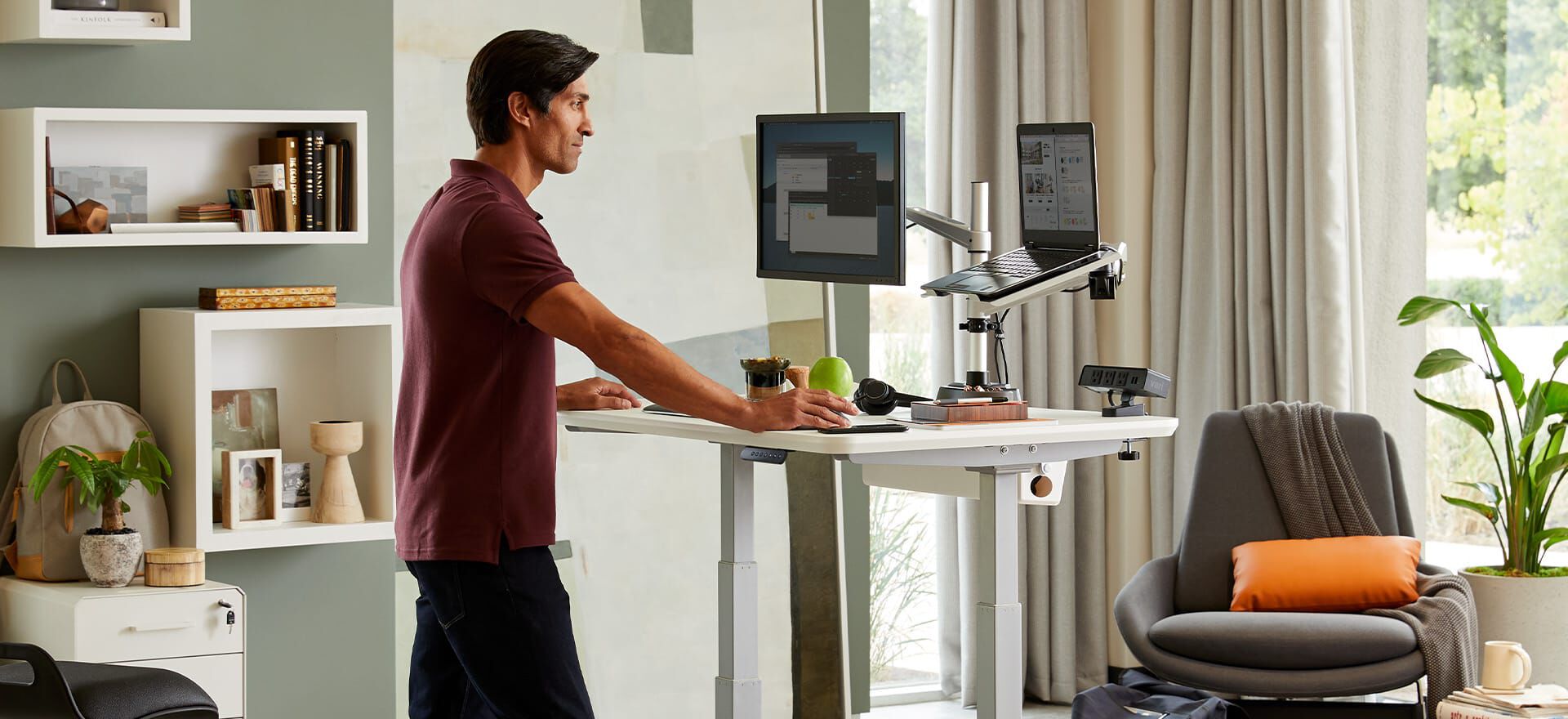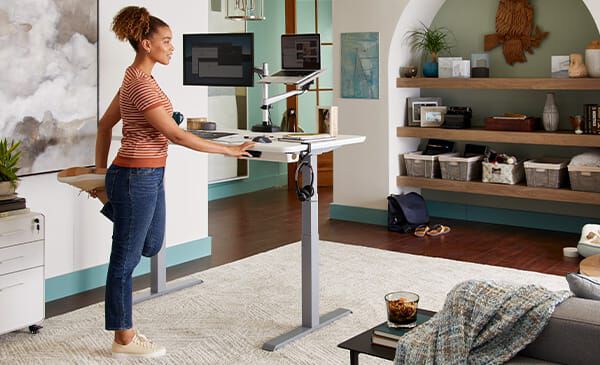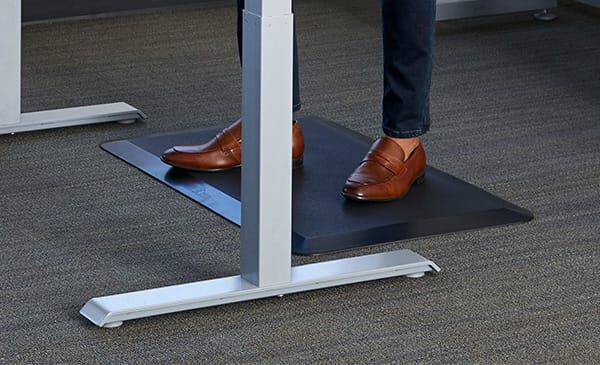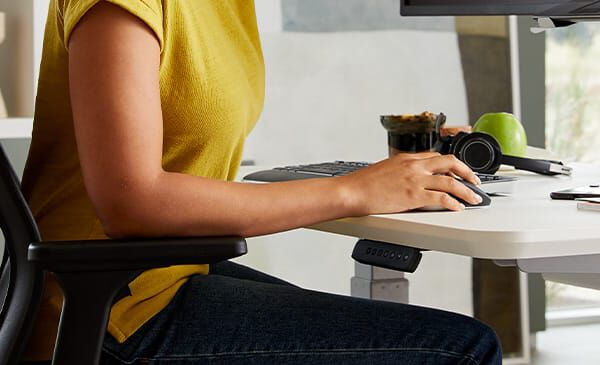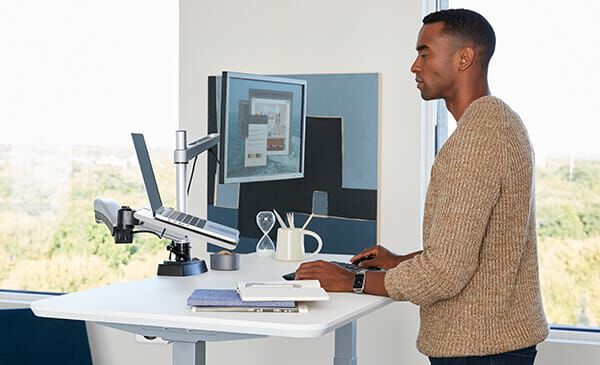TOP STANDING DESK MISTAKES TO AVOID
If you decided to purchase a sit/stand desk of your own, or if you already have one, here are a few common mistakes you’ll want to avoid to ensure you are sitting and standing the correct way.
5 Minute Read
It’s no news that standing while you work is becoming the new normal in the modern-day office. As people begin to realize the benefits of standing as opposed to sitting all day, standing desks are popping up in offices around the world. Standing desks can be a great tool to increase your health, productivity, and collaboration at work, but take note there are wrong ways and right ways to stand. Here are a few common mistakes you’ll want to avoid.
1. Standing too long
Many people have become accustomed to the belief that, if you own a standing desk, you should be standing all day. This is far from the truth. Studies* actually recommend that you work towards standing for two hours in the beginning and eventually build up to standing for four hours a day, alternating between sitting and standing. Too much of anything is a bad thing, so don’t negate your standing benefits by ditching sitting completely.
2. Not having your standing desk at the right height
Even when sitting, many people do not have their desks at the correct height for their bodies, but when standing, it becomes apparent very fast when your desk doesn't match your height.
A good rule to follow for standing desk posture and height is to keep your elbows at no less than a 90-degree angle and your screen at, or slightly below, eye level**. If you're having a tough time getting into the standing routine or feel like your standing desk isn't working its wonders, monitor arms can make a world of difference. Monitor arms specifically designed for standing desks can help you to maintain proper standing desk posture by adjusting your computer monitor height separately from your keyboard height.
3. No anti-fatigue mat
If you notice your feet getting especially tired while standing throughout the day, not having an anti-fatigue standing desk mat could be the cause. Having a mat under your feet not only gives you the extra cushion you need to stay comfortable while standing, but also encourages movement when standing.
4. Standing Still
One of the many benefits of standing over sitting is the greater ability to move around while working. Having a contoured standing mat or fun music on can help get you moving at your desk and make the most of your standing time.
5. Having Bad Posture
Posture is something that is extremely important to our health, yet we rarely pay attention to it on a daily basis. Having bad posture when you stand can really put a damper on your standing time and end up giving you as bad of back pain as you had when sitting. It can also cause a variety of health problems ranging anywhere from general fatigue to constricted blood vessels***. To improve your posture at work, you should:
- Stand with your head back, and hips upright with an 'S' curve in your spine
- Maintain good ergonomic principles: find a good chair, use proper pelvic support, and have your knees at 90 degrees
- Raise your monitor height to be level with your eyes
- Position your eyes to be 20-28 inches from the monitor screen
- Position your monitor to be at a 20-degree tilt
- Switch to a standing position every 20-30 minutes
Tips for Sitting – While many people choose standing desks because they allow them to move more throughout the day, we know that there are times when you will have to sit. And in our move towards healthy living, we believe it’s vital that you’re able to sit properly and with good posture. This not only improves the condition of your back and neck, but also ensures that the benefits of Vari sit/stand solutions aren’t counteracted. You’ll find a few tips below that you can use when you want sit.
Want more?
Stay informed. Sign up for our newsletter and get the latest resources and product updates.
How to Sit at a Standing Desk
1. Support your back
One of the first steps you can take to minimize back pain is to adjust your office chair or standing desk stool so that your lower back is supported. Proper support when you’re sitting reduces the strain on your back. Ideally, a chair that is adjustable will allow you to change the height, back position and tilt, allowing you to find the most suitable and supported sitting position. Another way of relieving back tension is to keep your knees in line with your hips, either by lowering your seat or resting your feet upon a footrest. When you sit in a chair, make sure that your hips are pushed as far back in the chair as they can go, while actively making an effort to sit straight, yet comfortable and relaxed. As a byproduct of this sitting posture, you’ll notice that your breathing may be easier, because your ribs can move more freely with your spine supported by the chair.
2. Find the right position for your wrists
In a proper sitting position, you should be able to use the keyboard with your wrists and forearms positioned straight. This is vital in the prevention of repetitive strain injuries that can take its toll on your wrists and forearms. Your elbows should rest by the side of your body forming an L-shape at the elbow joint, which is the position that Vari creates for you when you’re standing in front of your desk and working.
3. Feet firmly on the floor
One reason we recommend a footrest is because your feet should be firmly planted on the floor while you’re seated. This reduces the strain on your back by providing solid support beneath each of your legs. Crossing your legs can feel comfortable but can cause hip problems as well as cut off the circulation in your legs. It can also cause your back to tilt to one side or the other, placing more strain on one side and often resulting in back pain or stiffness.
4. Look forward, not down
Placing your computer screen a little bit lower than eye level reduces strain on your neck and shoulders, which can hunch over and result in incredibly bad posture. Keeping your screen at this level also reduces the risk of eye strain, which is a common complaint for workers who sit in front of a computer all day. By angling your screen slightly lower than your eye level, your neck is in a more natural position, reducing the strain on your back.
Now that you have these tips, you're ready to start reaping the benefits of your sit-stand desk.
Sources:
* British Journal of Sports Medicine. The Sedentary Office: A Growing Case for Change Towards Better Health and Productivity. 2015.
**"Arranging a Computer Workstation: Recommendations | Environmental Health and Safety | University of Pittsburgh." Arranging a Computer Workstation: Recommendations | Environmental Health and Safety | University of Pittsburgh. University of Pittsburgh, 26 Jan. 2016. Web. 21 Apr. 2016. https://www.ehs.pitt.edu/workplace/ergonomics/workstation.
***Nall, Rachel. "Health Problems From Bad Posture." Livestrong. Livestrong, 08 Sept. 2015. Web. 31 Mar. 2016. http://www.livestrong.com/article/437366-health-problems-from-bad-posture/.
